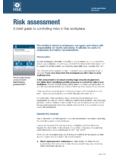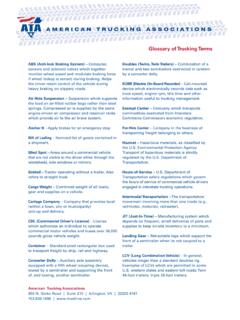Transcription of SENSATION AND PERCEPTION a unit lesson plan for high ...
1 Developed and produced by the Teachers of Psychology in Secondary Schools (TOPSS) of the American Psychological Association, November 2011 SENSATION ANDPERCEPTIONa unit lesson plan for high school psychology teachersSandra Alvarado, Bonnie Kanter-Braem, Kathleen Manz, Peter Masciopinto, Eileen McKenna, Dana Nelson, Christopher Williams, and Kent Korek2007 Revision TeamWilliam Wozniak, PhDUniversity of Nebraska at Kearney, Kearney, NEFaculty Consultant SENSATION and PercePtiona unit lesson plan for high school psychology teachersSandra Alvarado, Bonnie Kanter-Braem, Kathleen Manz, Peter Masciopinto, Eileen McKenna, Dana Nelson.
2 Christopher Williams, and Kent Korek 2007 Revision TeamWilliam Wozniak, PhD University of Nebraska at Kearney, Kearney, NE Faculty Consultantii SENSATION and PercePtiona unit lesson plan for high school psychology teachersSandra Alvarado, Bonnie Kanter-Braem, Kathleen Manz, Peter Masciopinto, Eileen McKenna, Dana Nelson, Christopher Williams, and Kent Korek 2007 Revision TeamWilliam Wozniak, PhD University of Nebraska at Kearney, Kearney, NE Faculty ConsultantThis unit is a revision of the original TOPSS Unit lesson Plan on SENSATION and PERCEPTION , written by Nancy Grayson, Kathleen Self, Martha J.
3 Whitacre, and Marvin Ziegler (Randal M. Ernst, Editor) originally prepared at the Texas A&M-NSF Summer Institute for the Teaching of AP and Honors Psychology in July unit is aligned with the following content standards of the National Standards for High School Psychology Curricula (APA, 2011):Standard Area: SENSATION and PerceptionContent Standards 1. The processes of SENSATION and perception2. The capabilities and limitations of sensory processes3. Interaction of the person and the environment in determining perceptionThe authors thank Bryan Burnham, PhD, of the University of Scranton; David Kreiner, PhD, of the University of Central Missouri; and Stephanie Simon-Dack, PhD, of Ball State University for their reviews of this document.
4 The authors also thank Alan Feldman of Glen Rock High School in Glen Rock, NJ, for providing valuable recommendations for the resources section. iii contents 1 Procedural Timeline 3 Introduction 5 Content Outline 19 Activities 39 References 41 Resources 49 Discussion QuestionsPrinting costs related to this lesson plan were supported by a grant from the American Psychological 2011 by the American Psychological 1: Introduction to SENSATION and PERCEPTION activity : SENSATION : Movement DetectorsLesson 2: Vision and AuditionActivity : Distribution of Rods, Cones, and Color Vision in the RetinaActivity : blind Spot in VisionActivity : Locating Sound Sources lesson 3: Other SensesActivity.
5 Sensory InterdependenciesLesson 4: PerceptionActivity : The Stroop Effectprocedural timelineprocedural outline3 SENSATION and PERCEPTION is an area in psychology that is demonstration-rich. In many cases, there is no need to collect many data points, compute averages, or do statistical testing to determine if an effect occurred. In most situations, the phenomenon can be seen or heard by the bonus is that many of the demonstrations are available to teachers on websites. Most websites have decent explanations presented alongside the demonstration (see the Resources section for examples).
6 Nonetheless, reviewing the websites prior to use is essential. Although the demonstrations might be explained well, slight differences could occur. These differences could be confusing to students. Thus, you will want to be sure the explanation is accurate. lesson 1 is an overview of SENSATION and PERCEPTION . The main purpose of the lesson is to give students the vocabulary for the study of SENSATION and PERCEPTION . lesson 1 connects these concepts to real-life situations such as hearing or vision 2 describes the visual and auditory systems. This lesson concerns neuroanatomy, focusing on the eye and ear.
7 It is possible to spice up the presentation by discussing disorders of SENSATION and PERCEPTION , such as near- and far-sightedness, color blindness, and some relatively rare brain disorders ( , prosopagnosia). lesson 3 reviews the other senses ( , gustation, olfaction, and somesthesis). lesson 4 moves to PERCEPTION , from the ability to sense a stimulus, to selecting and interpreting the stimulus. Some of the material is historically significant, such as the Gestalt approach, which remains an important set of concepts in contemporary psychology. The role that expectations play on a person s PERCEPTION is also 1: Introduction to SENSATION and Perceptionoverview: An important theme in this lesson is that external information gets recoded (transduced) into neural activity .
8 In other words, one type of information ( , light energy) is changed into a different type of information ( , neural activity in the optic nerve). There are limits on both the types and the amount of external information to which a person is sensitive. It is also important to note that the relationship between the external stimulus ( , the nominal stimulus) and the internal representation ( , the functional stimulus) is NOT SENSATION is the process by which we receive information from the environment. A. What kind of information? A stimulus is a detectable input from the environment: 1.
9 Light vision 2. Sound hearing 3. Chemicals taste and smell 4. Pressure, temperature, pain sense of touch 5. Orientation, balance kinesthetic senses B. Environmental information (stimuli) exists in many forms: 1. A physical stimulus must first be introduced. For example: air vibrations, gases, chemicals, tactile pressurescontent outlinecontent outline6 2. Our senses respond to a limited range of environmental stimuli. For example, we cannot hear sound of frequencies above 20,000 Hz, even though dogs can hear them. C. Some physical stimuli that our bodies are sensitive to: 1.
10 Light as experienced through vision a. Visible light is part of the electromagnetic spectrum. b. Properties of light i. Intensity (experienced as brightness) ii. Wavelength (experienced as hue) iii. Complexity or purity (experienced as saturation) 2. Sound as experienced through audition Properties of sound i. Intensity (influences mainly loudness) ii. Frequency (influences mainly pitch) iii. Wave form (influences mainly timbre) iv. As noted above, there is not a one-to-one relationship between physical properties and perceptual experience.












